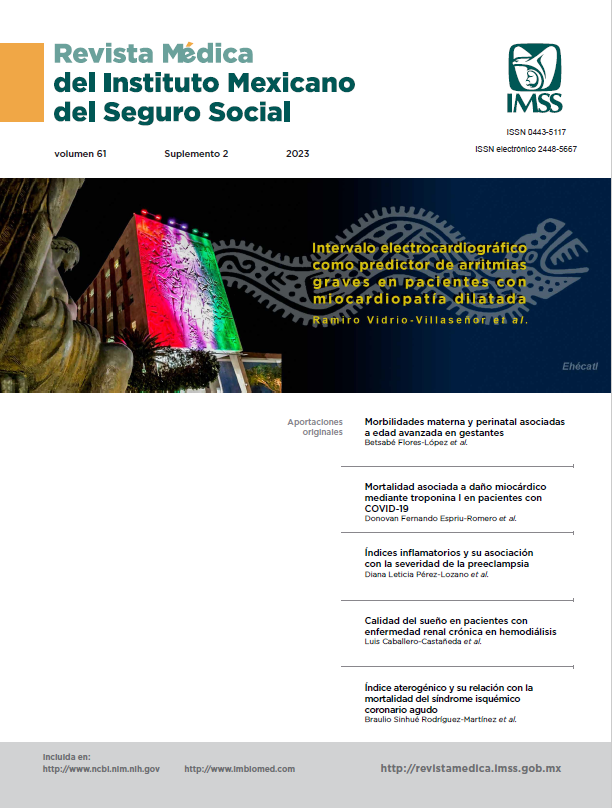Functional comparison between arthroscopy and open surgery for rotator cuff injuries
Main Article Content
Keywords
Comparative Study, Shoulder Joint, Arthroscopy, Rotator Cuff
Abstract
Background: Rotator cuff injuries result in impaired functionality of the shoulder. The difference in shoulder functionality in patients treated with arthroscopy who required open surgery is still unknown.
Objective: To determine if there is a difference in the functional evolution of the shoulder in patients who underwent surgery due to rotator cuff lesion which began with arthroscopy and ended in open surgery.
Material and methods: A cohort, longitudinal, observational and comparative study was carried out. The Constant scale was applied to measure the functionality of the shoulder in patients who underwent surgery due to rotator cuff injury, prior to surgery, 3 and 6 months after it, from August 2021 to April 2022. Functionality between patients who started with arthroscopy and required surgery and with those who only underwent arthroscopy was compared.
Results: 30 patients were included. Shoulder functionality in the preoperative period had a mean of 42.2 ± 18 (95% confidence interval [95% CI] 35.5-49.0), at 3 months of 48.18 ± 14 (95% CI 42.9-53.4) and at 6 months of 66.7 (95% CI 60.1-73.4), with a p = 0.001. The difference between the patients who required surgery was not significant (p = 0.3).
Conclusions: The functional evolution of the shoulder in patients who underwent surgery due to rotator cuff injury improves over time. The type of surgery does not influence the functional evolution.
References
Saavedra-Luna JA, Alvarado-Maya CS, Soria Guerra M. Guía de práctica clínica Diagnóstico y tratamiento del síndrome de hombro doloroso en primer nivel de atención. México: Instituto Mexicano del Seguro Social; 2016. Disponible en: https://www.imss.gob.mx/sites/all/statics/guiasclinicas/085GER.pdf.
Bustamante-Suárez de Puga D, Villegas-Robles E, Ortuño-Moreno J, et al. Resultados del tratamiento artroscópico de la rotura del manguito rotador en pacientes mayores de 60 años. Acta Ortop Mex. 2020;34(1):38-42. doi: 10.35366/94622.
Ramírez-Ortiz J, Mendoza-Eufracio JD, García- Viveros MR, et al. Costo-efectividad de esteroides locales combinados con ejercicio terapéutico en síndrome de pinzamiento subacromial. Rev Med Inst Mex Seguro Soc. 2017;55(5):608-14. Disponible en: http://revistamedica.imss.gob.mx/editorial/index.php/revista_medica/article/view/2359/2748.
Palma-Carpinteiro E, Barros A, Zurbano X, et al. Tratamiento mediante hilera única versus transóseos doble hilera en las roturas del mango de los rotadores de tamaño pequeño y mediano. Estudio prospectivo y aleatorizado. Revista Española de Artroscopia y Cirugía Articular. 2015;22(3):126-33. doi: 10.1016/j.reaca.2015.11.001.
Ochoa Cázares R, Narváez Corona RG, González Parás A. Manejo artroscópico en rupturas masivas del manguito rotador con espaciador subacromial. Acta Méd Grupo Ángeles. 2020;18(3):312-5. doi: 10.35366/95412.
Choi S, Kim MK, Kim GM, et al. Factors associated with clinical and structural outcomes after arthroscopic rotator cuff repair with a suture bridge technique in medium, large, and massive tears. J Shoulder Elbow Surg. 2014;23(11):1675-81. doi: 10.1016/j.jse.2014.02.021.
Thigpen CA, Shaffer MA, Kissenberth MJ. Knowing the speed limit: weighing the benefits and risks of rehabilitation progression after arthroscopic rotator cuff repair. Clin Sports Med. 2015;34(2):233-46. doi: 10.1016/j.csm.2014.12.007.
Sambandam SN, Khanna V, Gul A, et al. Rotator cuff tears: An evidence based approach. World J Orthop. 2015;6(11):902-18. doi: 10.5312/wjo.v6.i11.902.
Vrotsou K, Ávila M, Machón M, et al. Constant-Murley Score: systematic review and standardized evaluation in different shoulder pathologies. Qual Life Res. 2018;27(9):2217-26. doi: 10.1007/s11136-018-1875-7.
Constant CR, Murley AH. A clinical method of functional assessment of the shoulder. Clin Orthop Relat Res. 1987;(214):160-4. Disponible en: https://www.ncbi.nlm.nih.gov/pmc/articles/PMC6132990/
Osma Rueda J, Carreño Mesa F. Mango de los rotadores: epidemiología, factores de riesgo, historia natural de la enfermedad y pronóstico. Revisión de conceptos actuales. Revista Colombiana de Ortopedia y Traumatología. 2016;30 Supl 1. Disponible en: https://repositorio.fucsalud.edu.co/handle/001/1859.
Gómez Acevedo JM. El mango de los rotadores. Orthotips. 2014;10(3):144-53. Disponible en: https://www.medigraphic.com/pdfs/orthotips/ot-2014/ot143b.pdf .
Bond EC, Hunt L, Brick MJ, et al. Arthroscopic, open and mini-open approach for rotator cuff repair: no difference in pain or function at 24 months. ANZJSurg. 2017;88(1-2):50-5. doi: 10.1111/ans.14176.
Karaman O, Karakus O, Saygi B. A comparison of full arthroscopic and arthroscopic-assisted mini-open repair methods in rotator cuff tears 1-3 cm in size. J Orthop. 2018;15(3):894-98. doi: 10.1016/j.jor.2018.08.011.
Tahseen-Mehsen J, Saad-Madhi Z, Ali-Hasan M. Arthroscopic surgery versus mini-open repair of the full thickness rotator cuff tear, which intervention has the best outcome? Review of the latest evidence. AV FT. 2021; 40(6): 638-42. Disponible en: https://www.redalyc.org/journal/559/55969710014/55969710014.pdf.
Velasco-Alcázar R, Rojas-Sosa MC, Navarro-López MG, et al. Comparación de técnicas quirúrgicas para la lesión del mango de los rotadores: costo-resultado. Acta Ortopédica Mexicana. 2020;34(5):282-7. doi: 10.35366/97989.
Tonotsuka H, Sugaya H, Takahashi N, et al. Target range of motion at 3 months after arthroscopic rotator cuff repair and its effect on the final outcome. J Orthop Surg (Hong Kong). 2017;25(3):2309499017730423. doi: 10.1177/2309499017730423.
Keener JD, Galatz LM, Stobbs-Cucchi G, et al. Rehabilitation following arthroscopic rotator cuff repair: a prospective randomized trial of immobilization compared with early motion. J Bone Joint Surg Am. 2014;96(1):11-9. doi: 10.2106/JBJS.M.00034.
Gómez D, Dainotto T, Moya D, et al. Traducción y adaptación transcultural del Constant-Murley Score al español de la Argentina. Rev. Asoc. Arg. Ort. y Traumatol. 2022;87(4):579-92. Disponible en: https://raaot.org.ar/index.php/AAOTMAG/article/view/1491.
Carosi M, Galeoto G, Gennaro SD, et al. Transcultural reliability and validity of an Italian language version of the Constant–Murley Score. Journal of Orthopaedics, Trauma and Rehabilitation. 2020;27(2):186-91. doi: 10.1177/2210491720945327.
Barreto RPG, Barbosa MLL, Balbinotti MAA, et al. Versão brasileira do Constant-Murley Score (CMS-BR): validade convergente e de constructo consistência interna e unidimensionalidade. Rev Bras Ortop. 2016;51(5):515-20. Disponible en: https://cdn.publisher.gn1.link/rbo.org.br/pdf/51-5-port/5%20RBO%20162.pdf.


